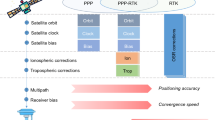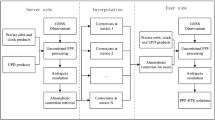Abstract
Precise point positioning (PPP) with augmentation by a network of continuously operating reference stations (CORS), known as PPP-RTK, enables fast ambiguity resolution with PPP. However, it suffers from the dependency of a CORS network for augmentation corrections generation. This paper proposes a new real-time PPP-RTK method that generates the augmentation corrections using undifferenced and uncombined PPP at a single reference station. This method enables high accuracy and fast convergence real-time PPP-RTK for both multi-frequency and single-frequency receivers without the need of PPP estimate convergence at the reference station. It provides potential flexibility to include any number of more local reference stations for augmentation correction generation. The method can be regarded as a state-space-representation based RTK approach that offers equivalent performance but can overcome the limitations associated with the observation-space-representation based positioning techniques, such as the high transmission rate and rigorous baseline length requirements. It can also be considered as a special case of the network-based PPP-RTK but it offers increased flexibility in system implementation and opens doors to develop new correction services for PPP-RTK applications. Field tests results validate the positioning performance of the proposed method. The static positioning test indicates that the method could instantly output cm-level positioning solutions even before the corrections estimate convergence at the reference station. And the kinematic vehicle-based test reveals that, the method can provide the rover station receiver cm-level positioning solutions with instant initialization and ambiguity resolution either using a dual-frequency Global Navigation Satellite System (GNSS) receiver or a low-cost single-frequency GNSS receiver with 100% ambiguity fix rate. Also, the test results with different baseline lengths prove that the proposed method will be gradually degraded into standard AR-enabled PPP when the baseline length grows longer, and the ambiguity can be effectively fixed even at the 1258 km baseline length.












Similar content being viewed by others
Data availability
Partial data and products used in this work are available for download from the Center for Orbit Determination in Europe (CODE), the rest data are available from the corresponding author on reasonable request.
References
Bock H, Jäggi A, Dach R, Schaer S, Beutler G (2009) GPS single-frequency orbit determination for low Earth orbiting satellites. Adv Space Res 43(5):783–791. https://doi.org/10.1016/j.asr.2008.12.003
Boehm J, Niell A, Tregoning P, Schuh H (2006) Global mapping function (GMF): a new empirical mapping function based on numerical weather model data. Geophys Res Lett. https://doi.org/10.1029/2005GL025546
Boehm J, Heinkelmann R, Schuh H (2007) Short note: a global model of pressure and temperature for geodetic applications. J Geod 81(10):679–683. https://doi.org/10.1007/s00190-007-0135-3
Chen K, Gao Y (2005) Real-time precise point positioning using single frequency data, pp 1514–1523
Collins P (2008) Isolating and estimating undifferenced GPS integer ambiguities, pp 720–732
Collins P, Langley R, LaMance J (1996) Limiting factors in tropospheric propagation delay error modelling for GPS airborne navigation, p 10
Feng Y, Gu S, Shi C, Rizos C (2013) A reference station-based GNSS computing mode to support unified precise point positioning and real-time kinematic services. J Geod 87(10):945–960. https://doi.org/10.1007/s00190-013-0659-7
Gao Y, Li Z, McLellan JF (1997) Carrier phase based regional area differential GPS for decimeter-level positioning and navigation, pp 1305–1313
Gao Y, Zhang Y, Chen K (2006) Development of a real-time single-frequency precise point positioning system and road test results, pp 2297–2303
Ge M, Gendt G, Rothacher M, Shi C, Liu J (2008) Resolution of GPS carrier-phase ambiguities in Precise Point Positioning (PPP) with daily observations. J Geod 82(7):389–399. https://doi.org/10.1007/s00190-007-0187-4
Geng J, Bock Y (2013) Triple-frequency GPS precise point positioning with rapid ambiguity resolution. J Geod 87(5):449–460. https://doi.org/10.1007/s00190-013-0619-2
Geng J, Bock Y (2016) GLONASS fractional-cycle bias estimation across inhomogeneous receivers for PPP ambiguity resolution. J Geod 90(4):379–396. https://doi.org/10.1007/s00190-015-0879-0
HAN S (1997) Carrier phase-based long-range GPS kinematic positioning. Ph.D. Thesis, p 185
Hatch R (1982) The synergism of GPS code and carrier measurements. In: Proceedings of the third international symposium on satellite doppler positioning at physical sciences laboratory of New Mexico State University. Las Cruces, NM, pp 1213–1231
Héroux P, Kouba J (1995) GPS precise point positioning with a difference. Natural Resources Canada, Geomatics Canada, Geodetic Survey Division
Jonge P, Tiberius CCJM (1996) The LAMBDA method for integer ambiguity estimation: implementation aspects. Delft Geodetic Computing Centre LGR Series 12
Khodabandeh A (2021) Single-station PPP-RTK: correction latency and ambiguity resolution performance. J Geod 95(4):42. https://doi.org/10.1007/s00190-021-01490-z
Khodabandeh A, Teunissen PJG (2015) An analytical study of PPP-RTK corrections: precision, correlation and user-impact. J Geod 89(11):1109–1132. https://doi.org/10.1007/s00190-015-0838-9
Klobuchar JA (1987) Ionospheric time-delay algorithm for single-frequency GPS users. IEEE Trans Aerosp Electron Syst AES 23(3):325–331. https://doi.org/10.1109/TAES.1987.310829
Laurichesse D, Blot A (2015) New CNES real time products including Beidou. IGS Mail No 7183
Laurichesse D, Mercier F (2007) Integer ambiguity resolution on undifferenced gps phase measurements and its application to PPP, pp 839–848
Li X, Zhang X, Ge M (2011) Regional reference network augmented precise point positioning for instantaneous ambiguity resolution. J Geod 85(3):151–158. https://doi.org/10.1007/s00190-010-0424-0
Li Z, Yuan Y, Wang N, Hernandez-Pajares M, Huo X (2015) SHPTS: towards a new method for generating precise global ionospheric TEC map based on spherical harmonic and generalized trigonometric series functions. J Geod 89(4):331–345. https://doi.org/10.1007/s00190-014-0778-9
Loyer S, Perosanz F, Mercier F, Capdeville H, Marty J-C (2012) Zero-difference GPS ambiguity resolution at CNES–CLS IGS Analysis Center. J Geod 86(11):991–1003. https://doi.org/10.1007/s00190-012-0559-2
Melbourne W (1985) The case for ranging in GPS-based geodetic systems. In: Proceedings of 1st international symposium on precise positioning with GPS, pp 373–386
Mervart L, Beutler G, Rothacher M, Wild U (1994) Ambiguity resolution strategies using the results of the International GPS Geodynamics Service (IGS). Bull Géod 68(1):29–38. https://doi.org/10.1007/BF00806750
Odijk D, Zhang B, Khodabandeh A, Odolinski R, Teunissen PJ (2016) On the estimability of parameters in undifferenced, uncombined GNSS network and PPP-RTK user models by means of S-system theory. J Geodesy 90(1):15–44
Raquet J, Lachapelle G, Fortes LPS (1998) Use of a covariance analysis technique for predicting performance of regional area differential code and carrier-phase, pp 1345–1354
Saastamoinen J (1972) Atmospheric correction for the troposphere and stratosphere in radio ranging satellites. In: The use of artificial satellites for geodesy. American Geophysical Union (AGU), pp 247–251
Shi J, Gao Y (2014) A comparison of three PPP integer ambiguity resolution methods. GPS Solut 18(4):519–528. https://doi.org/10.1007/s10291-013-0348-2
Shi C, Gu S, Lou Y, Ge M (2012) An improved approach to model ionospheric delays for single-frequency Precise Point Positioning. Adv Space Res 49(12):1698–1708. https://doi.org/10.1016/j.asr.2012.03.016
Shu Y, Shi Y, Xu P, Niu X, Liu J (2017) Error analysis of high-rate GNSS precise point positioning for seismic wave measurement. Adv Space Res 59(11):2691–2713. https://doi.org/10.1016/j.asr.2017.02.006
Teunissen P (1985) Zero order design: generalized inverses, adjustment, the datum problem and s-transformations. In: Grafarend EW, Sansò F (eds) Optimization and design of geodetic networks. Springer, Berlin, pp 11–55
Teunissen PJG, Khodabandeh A (2015) Review and principles of PPP-RTK methods. J Geod 89(3):217–240
Teunissen P, Joosten P, Tiberius CCJM (1999) Geometry-free ambiguity success rates in case of partial fixing. In: Proceedings of ION-NTM 1999
Teunissen PJ, Odijk D, Zhang B (2010) PPP-RTK: results of CORS network-based PPP with integer ambiguity resolution. J Aeronaut Astronaut Aviat Ser A 42(4):223–230
Wabbena G, Schmitz M, Bagge A (2005) PPP-RTK: precise point positioning using state-space representation in RTK networks, pp 2584–2594
Wang J, Huang G, Yang Y, Zhang Q, Gao Y, Xiao G (2019) FCB estimation with three different PPP models: equivalence analysis and experiment tests. GPS Solut 23(4):93. https://doi.org/10.1007/s10291-019-0887-2
Wanninger L (1995) Improved ambiguity resolution by regional differential modelling of the ionosphere, pp 55–62
Wübbena G, Bagge A, Seeber G, Böder V, Hankemeier P (1996) Reducing distance dependent errors for real-time precise DGPS applications by establishing reference station networks. In: PROCEEDINGS OF ION GPS. Institute of Navigation, pp 1845–1852
Wubbena G (1985) Software developments for geodetic positioning with GPS using TI 4100 code and carrier measurements. In: Proceedings 1st international symposium on precise positioning with the global positioning system. US Department of Commerce, pp 403–412
Xiang Y, Gao Y (2017) Improving DCB estimation using uncombined PPP. NAVIG J Inst Navig 64(4):463–473. https://doi.org/10.1002/navi.207
Xu P, Shi C, Liu J (2012) Integer estimation methods for GPS ambiguity resolution: an applications oriented review and improvement. Surv Rev 44(324):59–71. https://doi.org/10.1179/1752270611Y.0000000004
Xu P, Shi C, Fang R, Liu J, Niu X, Zhang Q, Yanagidani T (2013) High-rate precise point positioning (PPP) to measure seismic wave motions: an experimental comparison of GPS PPP with inertial measurement units. J Geod 87(4):361–372. https://doi.org/10.1007/s00190-012-0606-z
Yao YB, He CY, Zhang B, Xu CQ (2013) A new global zenith tropospheric delay model GZTD. Chin J Geophys 56(7):2218–2227. https://doi.org/10.6038/cjg20130709
Yao Y, Hu Y, Yu C, Zhang B, Guo J (2016) An improved global zenith tropospheric delay model GZTD2 considering diurnal variations. Nonlinear Process Geophys 23(3):127–136. https://doi.org/10.5194/npg-23-127-2016
Yigit CO, Gurlek E (2017) Experimental testing of high-rate GNSS precise point positioning (PPP) method for detecting dynamic vertical displacement response of engineering structures. Geomat Nat Haz Risk 8(2):893–904. https://doi.org/10.1080/19475705.2017.1284160
Zhang B, Teunissen PJG, Odijk D (2011) A novel un-differenced PPP-RTK concept. J Navig 64(S1):S180–S191. https://doi.org/10.1017/S0373463311000361
Zhang B, Ou J, Yuan Y, Li Z (2012) Extraction of line-of-sight ionospheric observables from GPS data using precise point positioning. Sci China Earth Sci 55(11):1919–1928
Zhang X, He X, Liu W (2017) Characteristics of systematic errors in the BDS Hatch–Melbourne–Wübbena combination and its influence on wide-lane ambiguity resolution. GPS Solut 21(1):265–277. https://doi.org/10.1007/s10291-016-0520-6
Zhang B, Chen Y, Yuan Y (2019) PPP-RTK based on undifferenced and uncombined observations: theoretical and practical aspects. J Geod 93(7):1011–1024. https://doi.org/10.1007/s00190-018-1220-5
Zumberge JF, Heflin MB, Jefferson DC, Watkins MM, Webb FH (1997) Precise point positioning for the efficient and robust analysis of GPS data from large networks. J Geophys Res Solid Earth 102(B3):5005–5017. https://doi.org/10.1029/96JB03860
Acknowledgements
The authors wish to acknowledge the financial supports from the Natural Sciences and Engineering Research Council of Canada (NSERC), the Centre National d’Etudes Spatiales (GFZ) for providing open access real-time orbit/clock and ionosphere corrections products, and the International GNSS Service (IGS) for providing the public access GNSS observation data.
Author information
Authors and Affiliations
Contributions
ZL designed the research, processed and analyzed the data and prepared the paper draft; YG supervised the research and revised the manuscript.
Corresponding author
Rights and permissions
About this article
Cite this article
Lyu, Z., Gao, Y. PPP-RTK with augmentation from a single reference station. J Geod 96, 40 (2022). https://doi.org/10.1007/s00190-022-01627-8
Received:
Accepted:
Published:
DOI: https://doi.org/10.1007/s00190-022-01627-8




